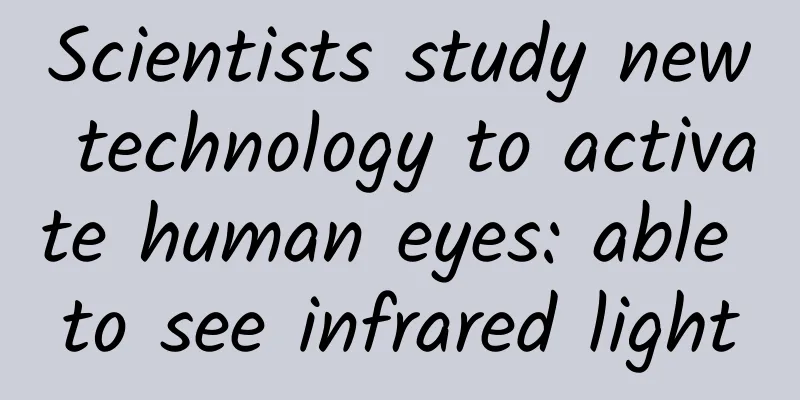Scientists study new technology to activate human eyes: able to see infrared light

|
Any science textbook will probably say that humans cannot see infrared light. Invisible light, such as X-rays, radio waves and infrared light waves, is beyond the visible spectrum. However, an international team of scientists, led by Washington University School of Medicine in St. Louis, has found that under certain circumstances, the human eye may be able to perceive infrared light. Using retinal cells from mice and humans and powerful lasers that deliver pulses of infrared light, the researchers found that when the laser pulses at high speeds, photoreceptor cells in the retina can sometimes receive hits of infrared energy. When this happens, the human eye can detect light outside the visible range. "With these results, we are trying to develop a new tool that will allow physicians to not only examine both eyes, but also stimulate specific parts of the retina to determine if it is functioning properly," said senior investigator Dr. Vladimir Kvalov, an associate professor of ophthalmology and visual sciences at Washington University. "We hope that this discovery will eventually have some practical applications." The study was published Dec. 1 in the journal Proceedings of the National Academy of Sciences, with co-authors including scientists from Cleveland, Poland, Switzerland and Norway. The research began when some of the team's scientists reported seeing occasional green flashes while working with infrared lasers. Unlike the laser pointers used in lecture halls and toys, the powerful infrared lasers the scientists used emit light waves that are invisible to the human eye. "They can occasionally see laser light beyond the normal visible range, and we wanted to find out how they perceive light that is not normally visible," said Dr. Frans Weinberg, one of the study's lead authors and a postdoctoral researcher at the UW School of Ophthalmology and Visual Sciences. Weinberg, Kvalov and their colleagues reviewed the scientific literature and reexamined reports of infrared light sightings. They repeated experiments in which infrared light was allegedly seen and analyzed light emitted by different lasers to investigate why and how infrared light sometimes becomes visible. "We experimented with laser pulses that sent the same number of photons but of different lengths, and found that the shorter the pulse, the more likely it was to be visible," Weinberg explains. "Even though the intervals between the pulses are so short that they are imperceptible to the naked eye, the presence of these pulses is important for the human eye to see this invisible light." Normally, when a photon is absorbed by the retina, it creates a molecule called a photopigment and begins the process of converting light into vision. In standard vision, each of the large number of photopigments absorbs one photon. The large number of photons accumulated in the short pulses of the high-frequency laser makes it possible for a single pigment to absorb two photons at a time, and the combined energy of the two photons is enough to activate the pigment, allowing researchers to see light that is not visible under normal circumstances. "The visible spectrum includes wavelengths between 400 and 720 nanometers," Kvalov explained. "But if a pair of 1,000-nanometer-long photons hit a pigment molecule in the retina in rapid succession, the energy delivered by these photons is the same as a single hit by a 500-nanometer-wavelength photon, which is well within the visible spectrum, which is why invisible light can be seen." Although the researchers are the first to report that the eye can sense invisible light through this mechanism, it is not unprecedented to use less powerful lasers to make things visible. For example, two-photon microscopy uses lasers to detect fluorescent molecules deep in tissue. The researchers say they are already studying how to apply the two-molecule method to a new type of ophthalmoscope, which will help doctors examine the inside of a patient's eye. By shining pulsed infrared lasers into a patient's eye, doctors can stimulate parts of the retina to understand the structure and function of healthy eyes and those with retinal diseases, such as macular degeneration. This research was made possible in part by a tool that Kvalov developed that allows scientists to obtain light responses from retinal cells and pigment molecules. The device has been commercialized and is in use at several vision research centers around the world. The research was supported by grants from the National Eye Institute (NEI), the National Institute on Aging (NIA) of the National Institutes of Health (NIH), Research to Prevent Blindness, the Norwegian Research Foundation, the European Union and the Polish Science Foundation. As a winner of Toutiao's Qingyun Plan and Baijiahao's Bai+ Plan, the 2019 Baidu Digital Author of the Year, the Baijiahao's Most Popular Author in the Technology Field, the 2019 Sogou Technology and Culture Author, and the 2021 Baijiahao Quarterly Influential Creator, he has won many awards, including the 2013 Sohu Best Industry Media Person, the 2015 China New Media Entrepreneurship Competition Beijing Third Place, the 2015 Guangmang Experience Award, the 2015 China New Media Entrepreneurship Competition Finals Third Place, and the 2018 Baidu Dynamic Annual Powerful Celebrity. |
Recommend
Starting operations from scratch: Keep’s 100-day advancement
There is a reason why Keep is so popular. The ope...
The whole practical process from 0 to 1 growth!
Before I came into contact with the working metho...
Valuation Modeling Skills Enhancement Course (Fifth Edition)
Resource introduction of Valuation Modeling Skill...
Bangshang Media's "Online Special Training Camp for Live Broadcasting Anchors" helps new anchors grow rapidly
Bangshang Media's "Online Special Traini...
How to become a qualified information flow advertising optimizer?
In our daily work, we have all read a lot of usef...
This article summarizes Keep’s textbook-like operating strategy: How to get users to help you promote?
The trend of sports is prevalent, and every produ...
Zhao, Qian, Sun, Li, Zhou, Wu, Zheng, Wang...How did these surnames come about?
Who am I? Where do I come from? Leaving aside the...
How to optimize and quickly increase the number of app store users?
On my first day at CallApp, the CEO gave me an ex...
Publicizing BOM prices is the best marketing position for latecomer LeEco
The LeEco mobile phone launch held on April 14 ma...
Notes from an e-commerce private domain operator!
Maybe everyone now knows what public domain and p...
Will iOS 9 become more stable?
iOS has undergone tremendous changes since iOS 7,...
Practical Methodology for B-side Operations to Acquire 50,000+ Customers
The article is divided into three parts: Overview...
46 million people have collected all five blessings! Alipay announces two more places to get blessing cards
Have you collected all the “Five Blessings”? The ...
Starting from Google: The future of the Internet will be full of monopolies
[[149274]] September 4, 2015 was Google's 17t...









